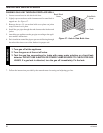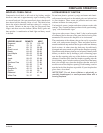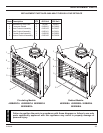
32 61D0008
12"max.
A
B
TRIM AND MANTEL INSTALLATION FOR WOOD BURNING FIREPLACES
• The fireplace face may be left exposed or trimmed. If trim is installed, fasten it securely to face of fireplace. Seal any
cracks between trim material and face of fireplace. Cracks can cause a fire and prevent fireplace from working prop-
erly.
• Place wall ties in mortar joints of masonry trim. Fasten wall ties to face of fireplace with sheet metal screws.
• Use only non-combustible materials below top of spacers.
Seal any space between face of
fireplace and non-combustible facing
material. Failure to seal this crack is a
possible fire hazard and will void the
warranty.
WARNING
Do not cover or restrict
side vent areas with
surround or trim materials
WARNING
LOCATING FRONT AND SIDE CLEARANCES
To find front clearances, extend a line from back corner of
unit to 4" in front of fireplace face and 1" outside screened
opening. Combustible materials may be placed within shaded
areas. Note: Do not let combustible materials overlap
black painted surface more than
1
/8". See Figure 41.
Trim may butt against side walls of fireplace. The other 3 walls
must have ¾" clearances.
Figure 40 - Spacer Location
Figure 41 - Front and Side Clearances
Figure 42 - Locating Mantel
LOCATING MANTEL
Maximum depth of mantel is 12"
A = 6½" - Minimum from top of fireplace opening to bottom
of any combustible trim material sticking out no
more than 1½" beyond face of fireplace
B = 12" - Minimum from top of fireplace opening to bottom
of combustible trim material sticking out more
than 1½" from top of fireplace opening
Top of
Fireplace
Opening
Combustible
Wallboard
Non-Combustible
Trim
Area to Be
Sealed
Combustible
Mantel
Non-
Combustible
Surround Trim
¾"
Separation
0" Clearance
to Front Side
Walls
4" Reference
Extended Line
1" Reference
Combustible
Material
within Shaded
Area
Combustible
Wallboard


















